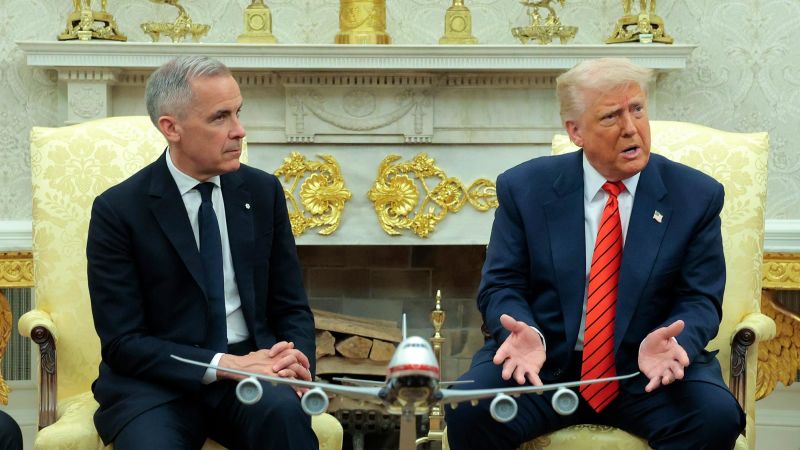The meeting between President Donald Trump and Canadian Prime Minister Mark Carney was marked by a palpable tension that illustrated the evolving relationship between the United States and Canada. The encounter, held in the Oval Office, was neither overly confrontational nor overtly warm. Instead, it exhibited an awkward atmosphere, lacking the cordiality that had characterized prior interactions between the two neighboring nations. As Trump’s remarks permeated the room, one could sense that the 5,525 mile border separating the two countries, once a symbol of harmony and cooperation, had taken on a different, more contentious significance.
During the meeting, Trump made a peculiar remark regarding the geographical boundaries of the two countries. He mused about the arbitrary nature of the border, describing it as if drawn by a ruler, and expressed an appreciation for the aesthetic simplicity it provided. “That’s the way it was meant to be,” he quipped, given his self-proclaimed artistic sensibility. However, Carney articulated a contrasting perspective, suggesting that the simplistic view Trump presented did not align with the historical and cultural realities of Canada. “I’m glad that you couldn’t tell what was going through my mind,” Carney later quipped to reporters, a clear signal that he was not entirely in agreement with Trump’s musings.
Despite the tone of the meeting, Carney did not shy away from asserting Canada’s sovereignty. Amidst Trump’s tendency to dominate the dialogue — he reportedly spoke 95% of the time on various subjects, including Middle Eastern politics and domestic rail systems — Carney’s interjections were noteworthy. He pointedly pushed back against Trump’s ambitions of assimilating Canada into the United States, quipping with a smirk, “As you know from real estate, there are some places that are never for sale.” This notable comment elicited a reluctant acknowledgment from Trump, signaling that while the conversation was lighthearted, the subject matter was serious.
Carney continued with his assertion of Canada’s status as an independent nation, citing Buckingham Palace as an example of something “never for sale.” He made it clear that Canada, despite the jokes, would not be annexed, stating emphatically, “It won’t be for sale ever.” This statement served its purpose, effectively reiterating that Canada would not entertain discussions of being integrated into the U.S. governance structure.
Furthermore, Carney’s stances during this meeting were not new; they echoed sentiments expressed during his recent campaign for prime minister, which was characterized by an anti-Trump sentiment that contributed to his electoral success. He had previously made headlines in Canada for rejecting notions that could imply a lesser status for his nation, including using the context of the upcoming visit from King Charles III to reinforce Canada’s independence.
As the interaction unfolded, it became apparent that while Carney was asserting Canada’s position, Trump appeared eager to avoid escalating tensions in their dialogue. Instead of challenging Carney’s assertions further, Trump opted to embrace a relatively mild tone, stating, “Never say never.” Carney’s repeated gestures of “never” appeared in a humorous light, suggesting a tension diffused through humor, even if the underlying issue was serious.
Despite setting the stage for a more collegial understanding, the meeting’s atmosphere remained tense and reflective of a broader deterioration in U.S.-Canada relations. Leading up to their discussions, Trump had made disparaging remarks on social media, declaring Canada overly dependent on the U.S. While their meeting seemed to mitigate immediate hostilities, the commentary from Trump persisted, reinforcing the perception that the relations were fragile at best.
In conclusion, while the encounter between Trump and Carney in the Oval Office lacked open hostility, it was underscored by a complex interplay of assertiveness and vulnerability. Carney’s declarations underscored Canada’s sovereignty and independence, yet despite steps toward reconciliation, the back and forth was symptomatic of underlying issues that linger quietly beneath the surface. The future of U.S.-Canada relations remained uncertain, leaving observers to ponder what would unfold in subsequent diplomatic engagements. As they prepared for another meeting at the upcoming G7 summit in Alberta, both leaders knew the necessity of fostering a cooperative atmosphere amidst the strains woven into their nations’ ongoing discourse.



